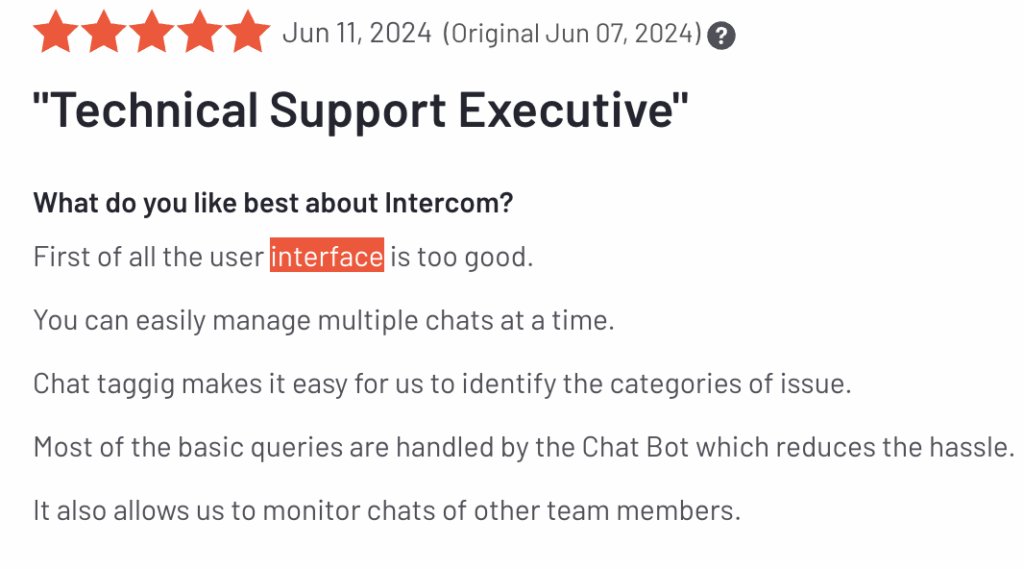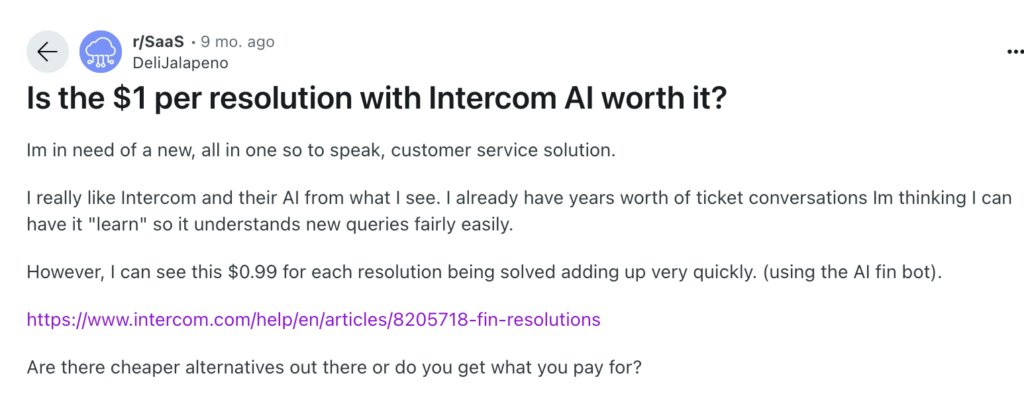Zendesk vs Intercom – A Detailed Comparison

Table of contents
Choosing the right customer service platform is critical for any business. It enables you to streamline all incoming customer queries, and ensure your support team is equipped to provide prompt, efficient solutions.
When you’re choosing the right tool that can help you do this, Zendesk and Intercom are two popular names that are likely to come up. Both are known for their range of features – AI, analytics, automation, and ticketing, amongst others.
But, which one is better and more value-for-money?
In this guide, I compare Zendesk and Intercom – on pricing and features – to help you make an informed decision.
Table of Contents
- Zendesk Overview
- Intercom Overview
- Zendesk vs Intercom – which one should you choose?
- Hiver – A better alternative
- Final Words
- Frequently Asked Questions (FAQs)
Zendesk Overview
Zendesk is a robust ticketing software. It provides one central hub for all your customer queries, that arrive via emails, phone calls, chats or social media.
The platform converts all customer queries into “tickets” that agents can handle with ease and track till the point of resolution.
Zendesk’s functionalities also include a knowledge base, internal collaboration tools, and an in-depth reporting dashboard that helps you assess quality of customer service and support staff performance.
Intercom Overview
Intercom redefines customer support with a conversational approach. By integrating seamlessly into your app, it offers an intuitive in-app chat experience that fosters direct customer engagement.
Core features include automated support powered by a knowledge base, a streamlined ticketing system built around messaging, and a powerful inbox to centralize all customer queries.
Intercom also offers extensive integrations with over 350 tools that include Salesforce, HubSpot, Google Analytics, Amplitude, Zoho, JIRA, and more. The platform is recognized for its ability to resolve a significant portion of customer questions automatically, ensuring faster response times.
Zendesk vs Intercom – which one should you choose?
Here’s a quick comparison of Zendesk vs Intercom.
| Criteria | Zendesk | Intercom |
|---|---|---|
| User Interface and Design | Traditional, slightly outdated but customizable | Modern, intuitive and conversational interface |
| Automation Features | Workflow automation, macros, conditional triggers | Automated messaging, bot responses, customer segmentation |
| Omnichannel Functionalities | Email, phone, chat, social media | In-app messaging, email, live chat, push notifications |
| Reporting and Analytics | Detailed performance metrics, custom reports | User behavior analytics, conversion tracking |
| Vendor Support Quality | Limited support for basic plans; premium support is costly; complex interface. | Quite responsive support as per users; occasional challenges with AI chatbot and help articles. |
| Pricing | Suite Team: $55/user/month; Suite Growth: $89/user/month; Suite Professional: $115/user/month. | Essential: $39/month; Advanced: $99/month; Expert: $139/month. |
1. User Interface and Design
Both Zendesk and Intercom have very different and distinct user interfaces. Let’s dive into how they differ.
Zendesk
Zendesk’s interface looks like any other traditional help desk. It’s characterized by a clear, organized layout with a strong focus on ticket management. The dashboard provides an overview of ticket volume, agent performance, and other key metrics. The ticket view often includes detailed information about the customer, history of interactions, and other details.
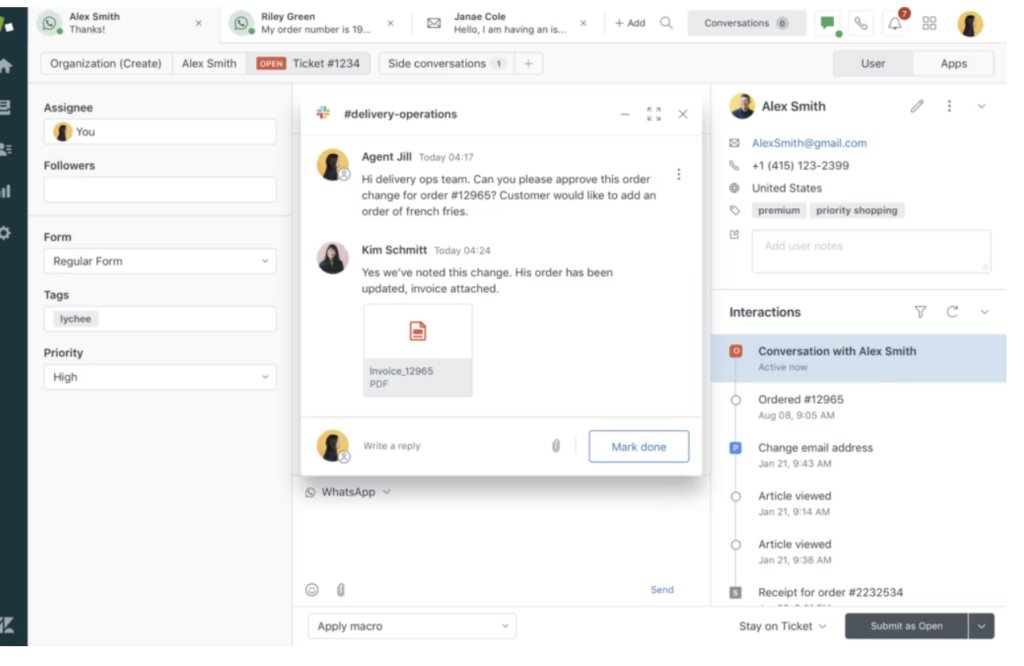
Although quite functional, Zendesk’s interface can sometimes feel a bit dated compared to other helpdesks. While it is designed to help support agents be efficient, it might not be as visually appealing or intuitive for users who aren’t very tech-savvy.
Recommended read: How it Genius saved 40 hours a month by moving from Zendesk to Hiver
Intercom
Intercom’s interface resembles that of a messaging app. That makes the design very familiar and user-friendly, for both customers and agents.
Since Intercom’s focus is on driving customer engagement, the interface prominently displays important features like in-app messaging and chatbots. The dashboard also provides insights into user behavior and engagement metrics.
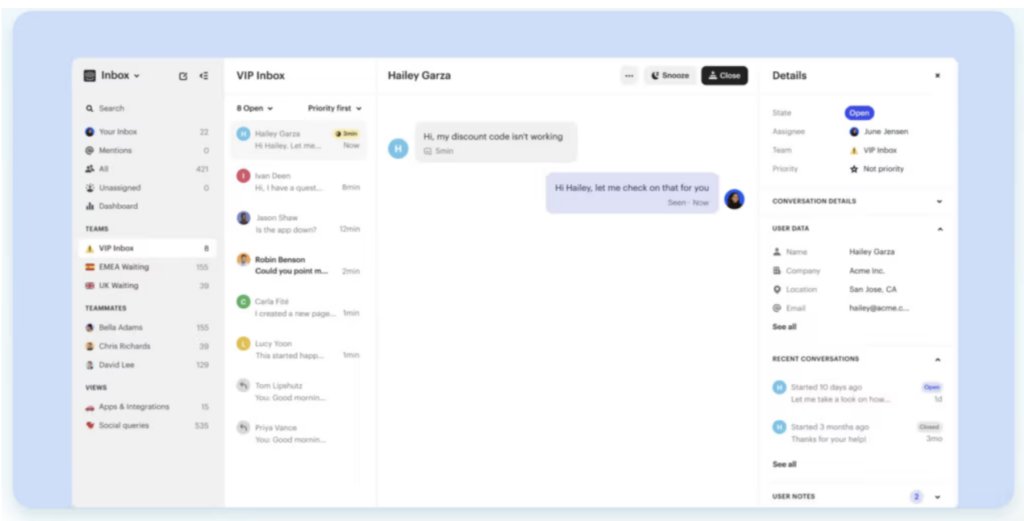
Intercom’s interface is generally praised for its clean and intuitive design. It prioritizes a seamless user experience and is more visually appealing than Zendesk.
The Verdict
Intercom generally has the edge when it comes to user interface and design. Its UI is visually appealing and easy to navigate. With its in-app messenger, the UI resembles a chat interface, making interactions feel conversational. This makes it a strong choice for businesses prioritizing customer engagement.
Here’s what an user has to stay about Intercom
2. Automation
Both Zendesk and Intercom offer automation features to streamline workflows and improve efficiency, but the way they do it is different.
Zendesk
Zendesk excels in ticket automation. It offers robust features for automating routine tasks such as ticket routing, creating queues, creating ticket statuses and more. Features like macros, triggers, and automations allow businesses to create custom workflows tailored to their specific needs.
For instance, Zendesk’s automation rules can help support teams automatically assign tickets based on specific criteria – like subject line or specific keywords. This ensures that the tickets reach the right agent instantly.
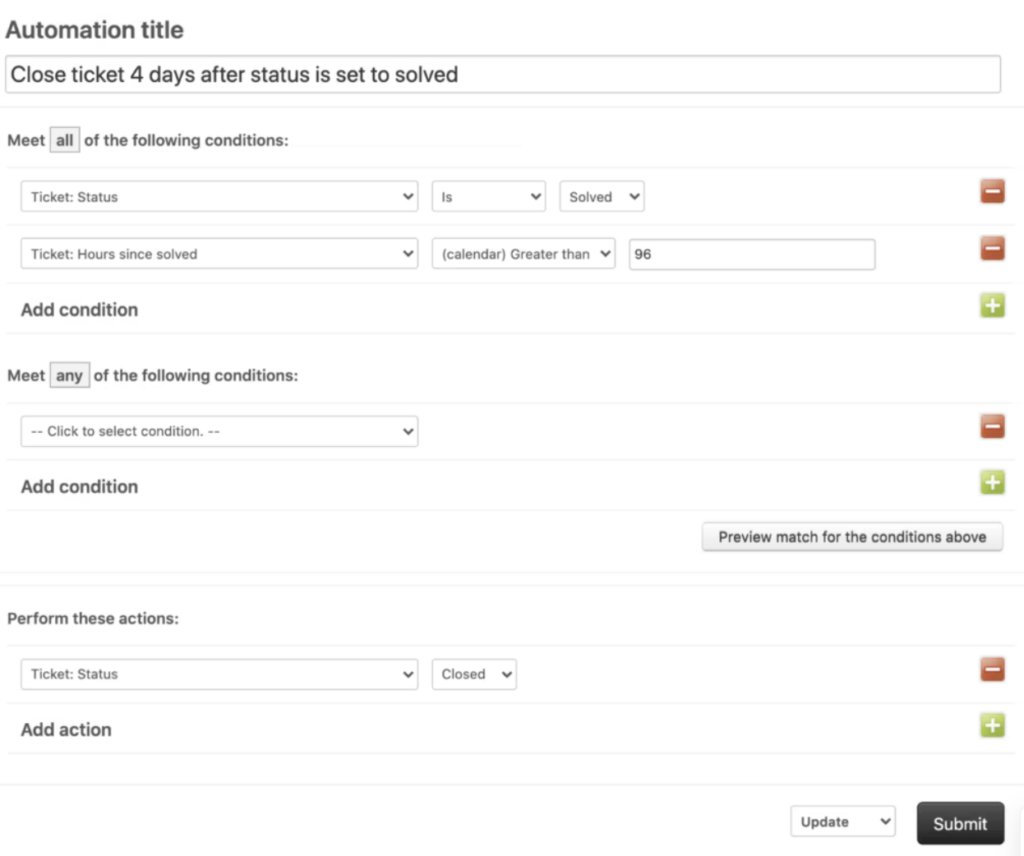
Intercom
Intercom, on the other hand, focuses on automating tasks that help improve customer engagement. For instance, if your audience tends to have questions at a certain stage of their user journey, Intercom can set triggers that share resources – with its AI-powered bots to help them clarify any doubts they might have.
With its automated messaging feature that can be customized based on customer segments, you can clearly see that Intercom’s features revolve around providing personalized experiences.
One stand out automation feature is its co-pilot, also known as Fin AI Copilot. It is an AI-powered assistant that functions as a knowledge base search tool, equipping agents with instant answers when they interact with customers, directly within the Intercom inbox.
There’s also another feature called ‘Fin AI Agent’. This helps companies resolve common customer queries without any human intervention.
Essentially, Fin AI Copilot acts as a personal assistant for every support staff, helping them resolve customer issues faster and more efficiently. Whereas, Fin AI Agent is an actual chatbot that responds on its own to customers’ questions.
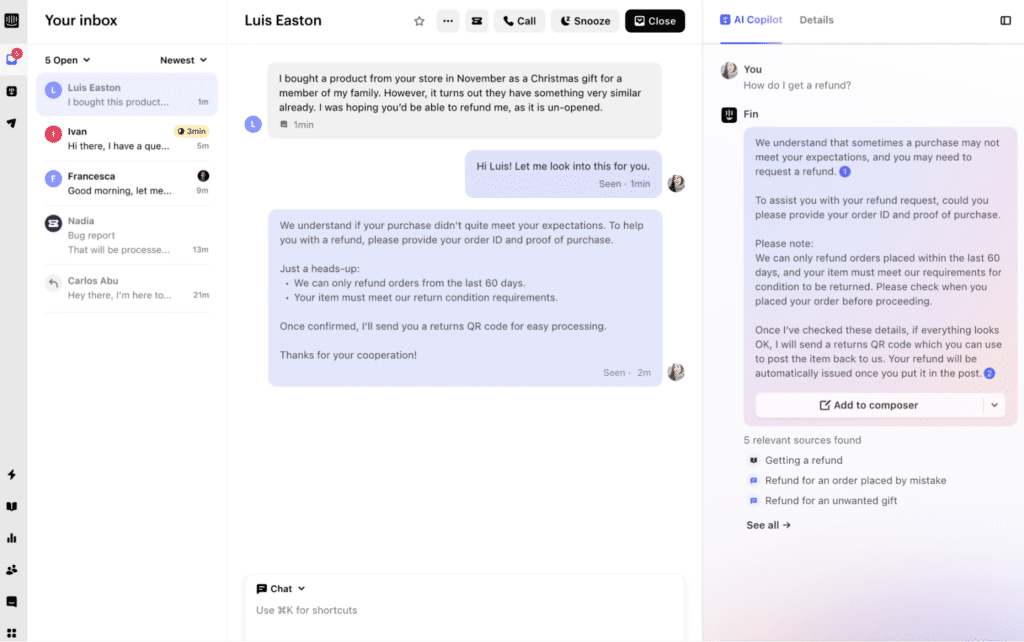
But, here’s a catch. While Fin AI Copilot – is included in all paid Intercom plans, you only get to use it for only ten conversations per agent each month. If your team needs Fin to help with more than that, you’ll need to pay an extra $35 per agent per month for unlimited use.
Similarly, if you require Fin AI Agent – to resolve customer queries without human intervention, you’ll need to pay an additional $0.99 per resolution. Keep in mind that this is an add-on expense, on top of your chosen plan.
The Verdict
Both the platforms offer valuable automation features, and the optimal choice depends on your business’s specific needs.
If ticket management and workflow optimization are your primary concerns, Zendesk’s automation capabilities might be a better fit. However, if you’re looking to improve your customer’s user journey with personalized conversations, Intercom’s automation features and AI assistant are likely to be beneficial.
But, it’s important to note that Intercom’s AI automation features can get really expensive. Here’s what an Intercom user had to say about it:
Recommended read: 10 Best Automated Ticketing Systems
3. Omnichannel Functionalities
Both Zendesk and Intercom offer a range of channels for businesses to interact with their customers. Let’s see how they compare against each other.
Zendesk
Zendesk helps you offer multichannel support for your customers. It supports channels like email, phone, and chat. It can also integrate with social media platforms. While it offers some basic real-time messaging features, its core focus is on ticketing and support.
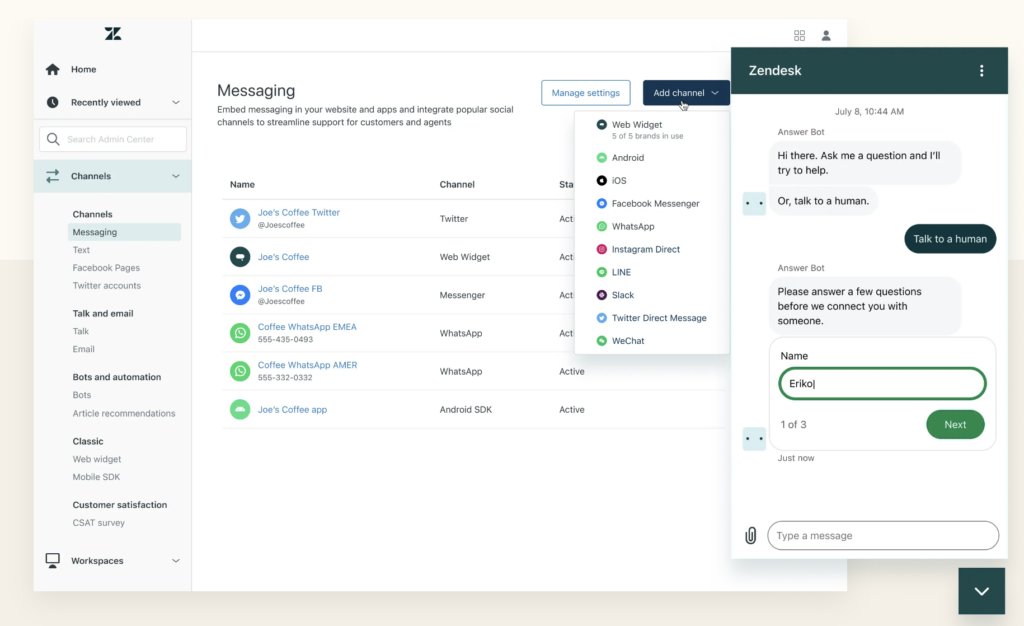
Intercom
Intercom primarily focuses on in-app messaging and chat. This makes it an ideal choice for businesses looking to engage customers directly within their product, app or website. It also supports email and other channels – like Whatsapp, SMS, social media channels and more, through integrations. But its core strength lies in providing a seamless, conversational experience for customers.
It offers a feature called “Mobile Push” which are essentially push notifications that allow businesses to reach customers on their mobile apps. This feature enables timely alerts and updates to customers, even when they are on the go.
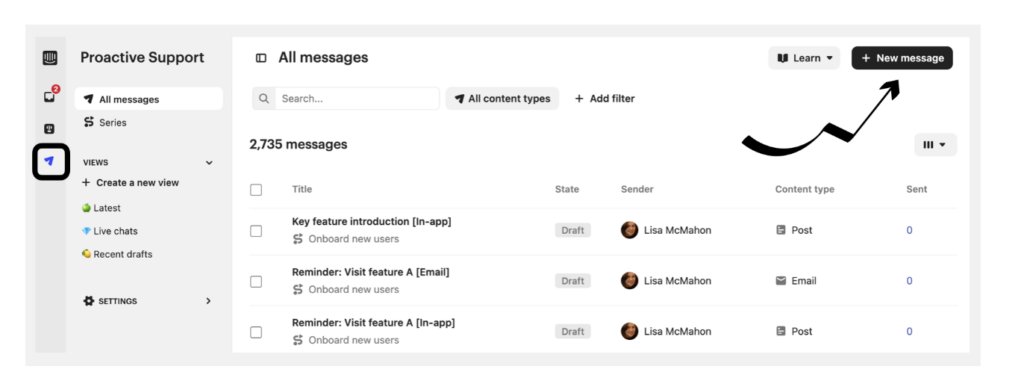
The Verdict
If your business requires a centralized platform to manage a high volume of customer inquiries across various channels, Zendesk is a solid choice.
However, if you prioritize in-app engagement and personalized communication, Intercom would be better. The way it combines contextual in-app messaging along with chat and push notifications is something that can help businesses keep their users fully engaged.
In fact, here’s how an user feels about Intercom:
Intercom had brought our mobile app to life adding a human touch our customers truly appreciate.
The UI is very nice. Its easy to use and easy on the eyes. We use Intercom mostly for customer support, to send push notifications, and to send emails. All of these functionalities work really great.
–User review on G2
4. Reporting and Analytics
Both Zendesk and Intercom offer in-depth reporting. What differentiates them is the kind of reports they equip your teams with.
Zendesk
Zendesk excels in providing in-depth performance metrics for your support team. It offers comprehensive insights on ticket volume, agent performance, customer satisfaction, first contact resolution rates and more.
A standout feature of Zendesk is its “Explore” functionality. Zendesk Explore allows you to create custom reports and visualizations in order to gain deeper insights into your support operations and setup.
With Explore, you can share and collaborate with anyone customer service reports. You can share these reports one-time or on a recurring basis with anyone in your organization.
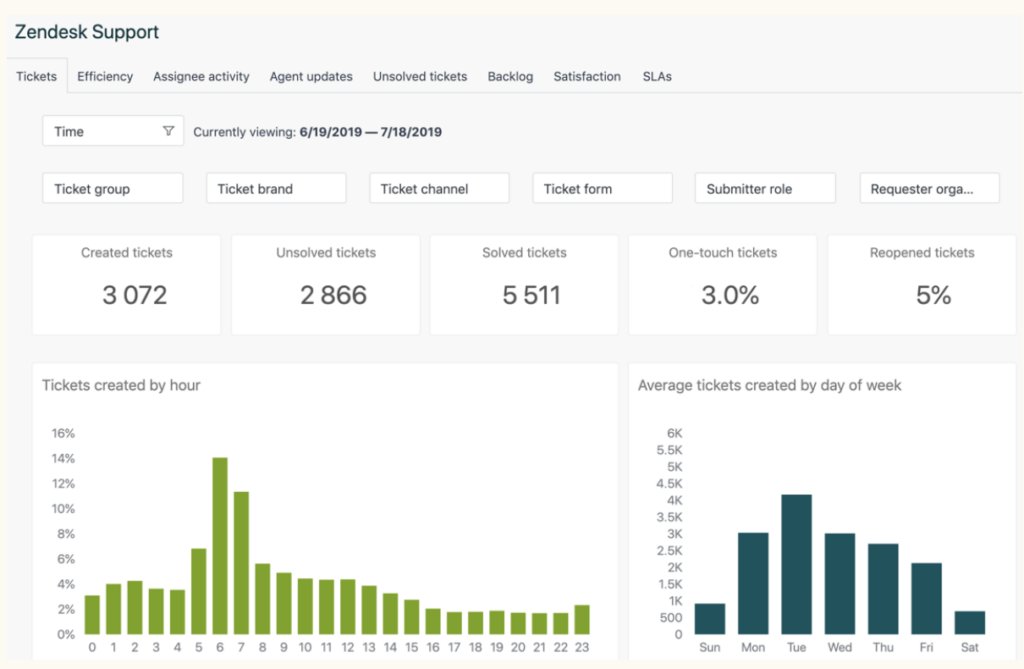
Intercom
Intercom’s analytics focuses more on user behavior and engagement metrics, with insights into customer interactions, and important retention metrics.
You can use the dashboards to understand customer journeys in-depth and identify areas of improvement. While it helps track some basic support metrics, Intercom’s strength lies in helping companies understand user behavior, product usage, and friction points along the journey.

Intercom actively enhances its analytics capabilities by leveraging AI to forecast customer behavior. This feature helps businesses anticipate and address potential issues before they escalate.
Here’s what an Intercom user has to say about its reporting capabilities:
“Intercom is super helpful for managing conversations with multiple clients and for tracking what is working and what isn’t working. The reporting has improved dramatically and it leaves you with actionable insights and takeaways. The introduction of FIN has also been a huge bonus for our team and company at large.“
–User review on TrustRadius
The Verdict
If you prioritize detailed support performance metrics and the ability to create custom reports, Zendesk’s reporting capabilities are likely to be more appealing.
However, if you’re interested in understanding customer behavior, product usage, and in need of AI-powered predictive insights, Intercom’s user analytics might be a better fit.
5. Vendor Support Quality
When you onboard a customer support platform, it’s important to consider the level of support the vendor offers. That’s because if there’s a glitch or a system outage, you want an immediate fix or clarity on the resolution.
Here are a few key points to consider:
Zendesk
Reaching out to Zendesk’s customer support team can be challenging, especially if you’re subscribed to their basic plan. That’s because Zendesk prioritizes its support services for users for its higher pricing plans. This approach can be a significant limitation for smaller businesses or those operating within a tight budget.
They have a 2-day SLA, no phone support, and many users have found it hard to find quick solutions to their issues.
“I would not recommend Zendesk for their lack of support alone. It seems that it’s been built to allow you to do most things but with a non-user-friendly UI.“
–User review of Zendesk’s support
Moreover, for users who require more dedicated and personalized support, Zendesk charges an additional premium. These premium support services can range between $1,500 and $2,800.
Intercom
Intercom generally receives positive feedback for its customer support, with users appreciating the comprehensive features and team-oriented tools. However, there are occasional criticisms regarding the effectiveness of its AI chatbot and some interface navigation challenges.
Intercom might be pricey but extremely competentchoice of chat.
“Very well! everything from sales calls, onboarding, setup and support have worked very well.”
User review on Captera
The Verdict
Zendesk which is less user-friendly and charges more for quality support, might not work for smaller businesses.
Intercom, on the other hand, is a better choice for those valuing comprehensive and user-friendly support, despite minor navigation issues.
6. Pricing
Pricing for both services varies based on the specific needs and scale of your business.
Zendesk
Zendesk offers a variety of plans under its Suite package, with annual subscription rates per agent per month as follows: Suite Team at $55, Suite Growth at $89,and Suite Professional at $115. To know the pricing of its Suite Enterprise plan, you’d need to contact their sales team.
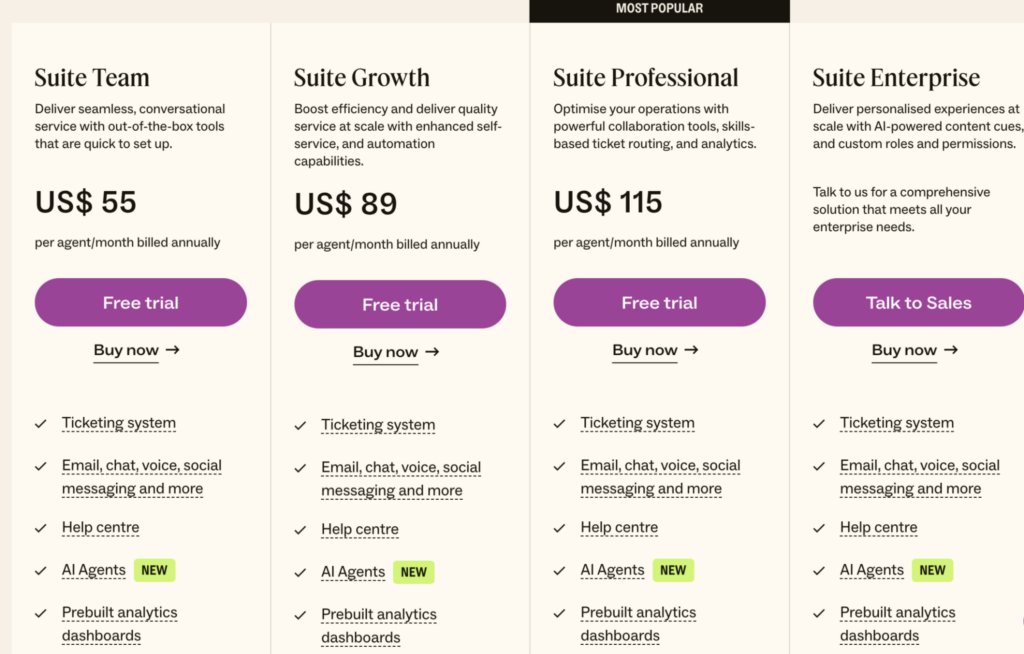
Recommended read: Zendesk costs 2x more than Hiver
Intercom
Intercom, on the other hand, provides three main plans: Essential at $39 per seat per month, Advanced at $99 per seat per month, and Expert at $139 per seat per month. Additional costs apply for features like AI chatbot resolutions, email campaigns, SMS, WhatsApp, and phone calls.
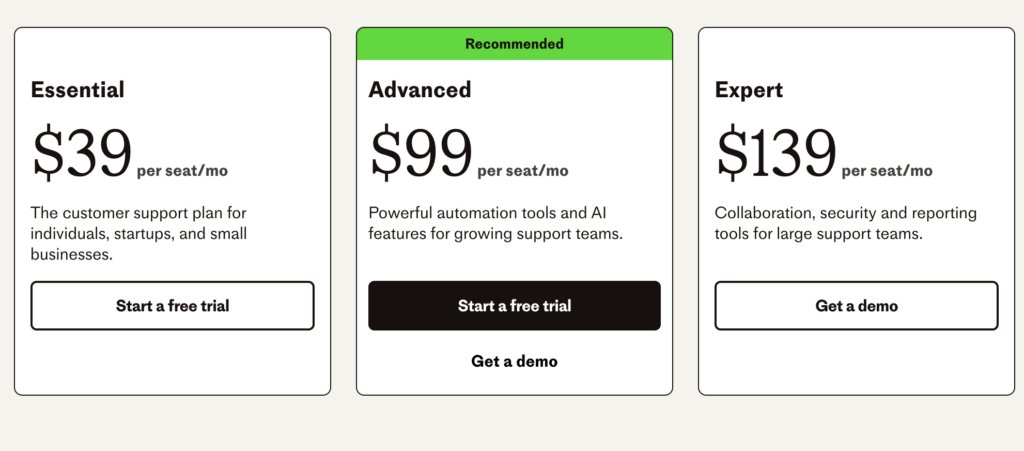
The Verdict
At surface-level, you may find Zendesk costlier than Intercom. But you also need to consider the fact that Intercom has many add-ons that cost extra, especially their AI features.
So, the actual pricing of Intercom would depend on whether or not you’re going to need their AI features – the AI Copilot and AI Agent. The AI Copilot is limited to assisting ten conversations per support agent and for anything more, it costs $35 per month per agent. Likewise, the AI Agent costs $0.99 per conversation.
Here’s what an user says about Intercom getting expensive with add-ons:
To sum up, if you are looking for a helpdesk with no advanced AI capabilities, you can choose Intercom. Their basic plan is cheaper than Zendesk, but you’ll not get to use any of their AI-powered add-ons.
But is it worth it?
While both Zendesk and Intercom offer robust features, their pricing models might still be a hurdle for businesses looking to just start out with a help desk on a comparatively smaller budget.
That’s where Hiver comes in. Starting at just $19/user/month, Hiver is a more affordable solution that doesn’t compromise on essential helpdesk functionalities.
Hiver – A better alternative
Hiver is a customer support platform that operates directly within your inbox, offering a seamless experience for businesses looking to streamline their support processes. Here’s a deep dive into what Hiver brings to the table:
1. Inbox-Based Interface
Hiver’s most significant selling point is how it seamlessly works on top of your inbox. This means there’s no new software to learn. Teams can manage customer emails directly from their inbox. This integration significantly reduces the learning curve and improves adoption rates within teams.
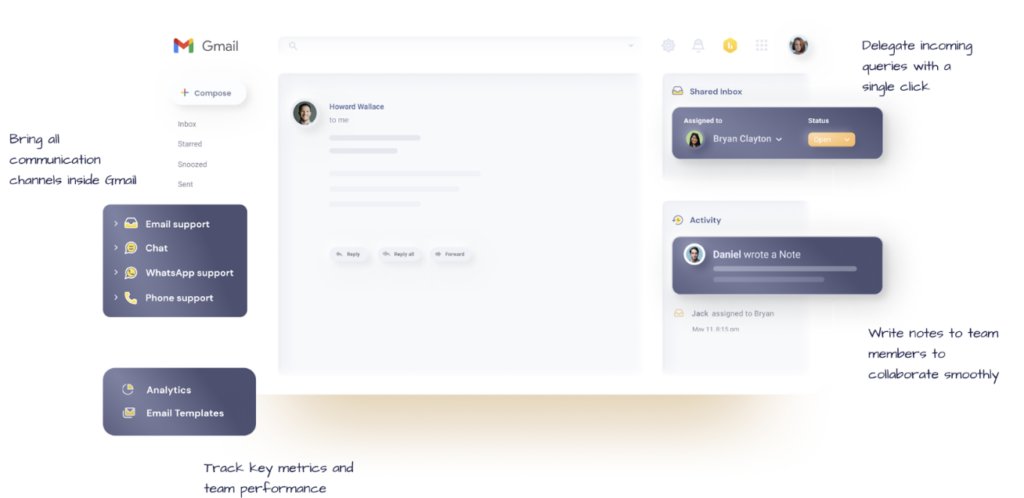
2. Query Assignment and Tracking
With Hiver, customer queries can be assigned to specific team members. This clarifies responsibility and ensures accountability. The platform also allows teams to track queries, enabling supervisors to monitor progress and ensure timely responses.
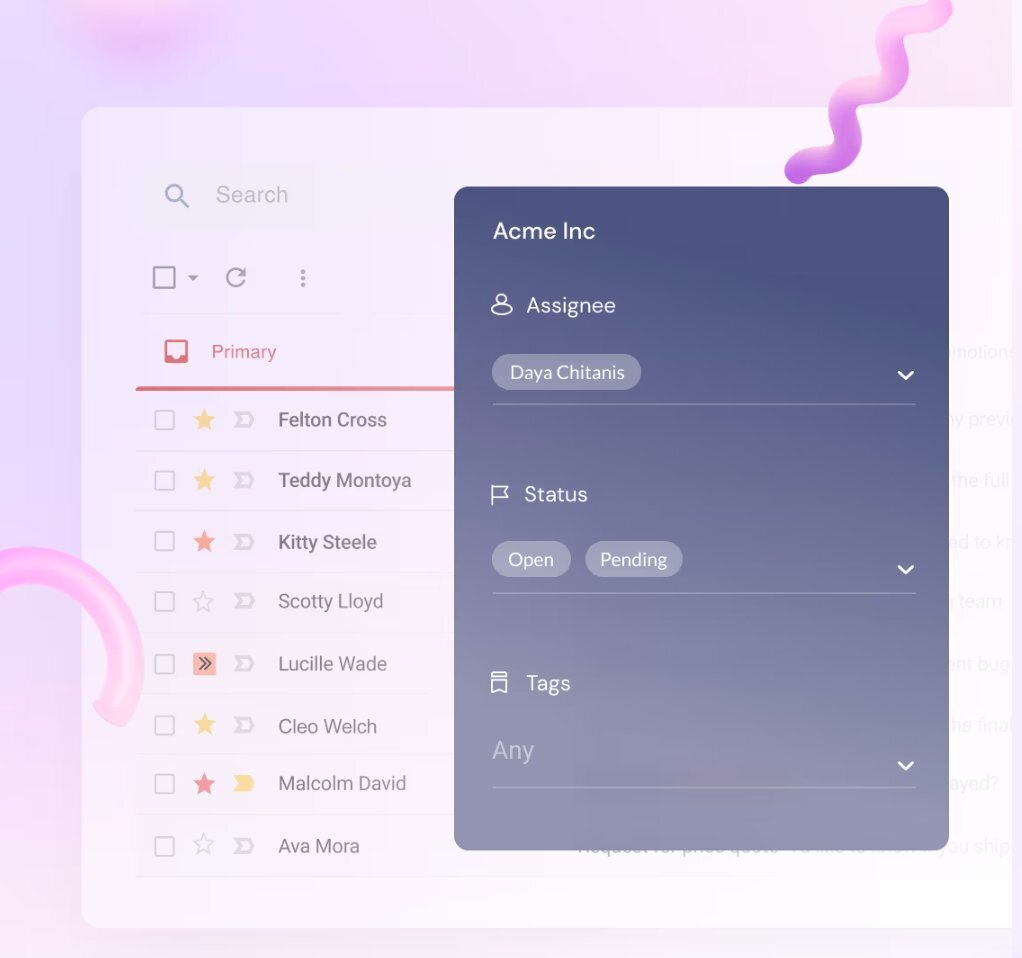
3. Collaboration
Hiver excels in fostering team collaboration in several innovative ways:
- Shared Email Drafts: Team members can co-compose emails in real-time. This feature is incredibly useful for crafting precise responses to complex customer queries.
- Internal Email Notes: Instead of forwarding emails or using external chat apps, team members can attach private notes directly to email threads. These notes are invisible to customers and provide a platform for internal discussion and quick information exchange.
- Collision Alerts: Hiver provides alerts if multiple team members happen to be responding to the same email. This feature prevents duplicate responses and ensures a more organized communication strategy.
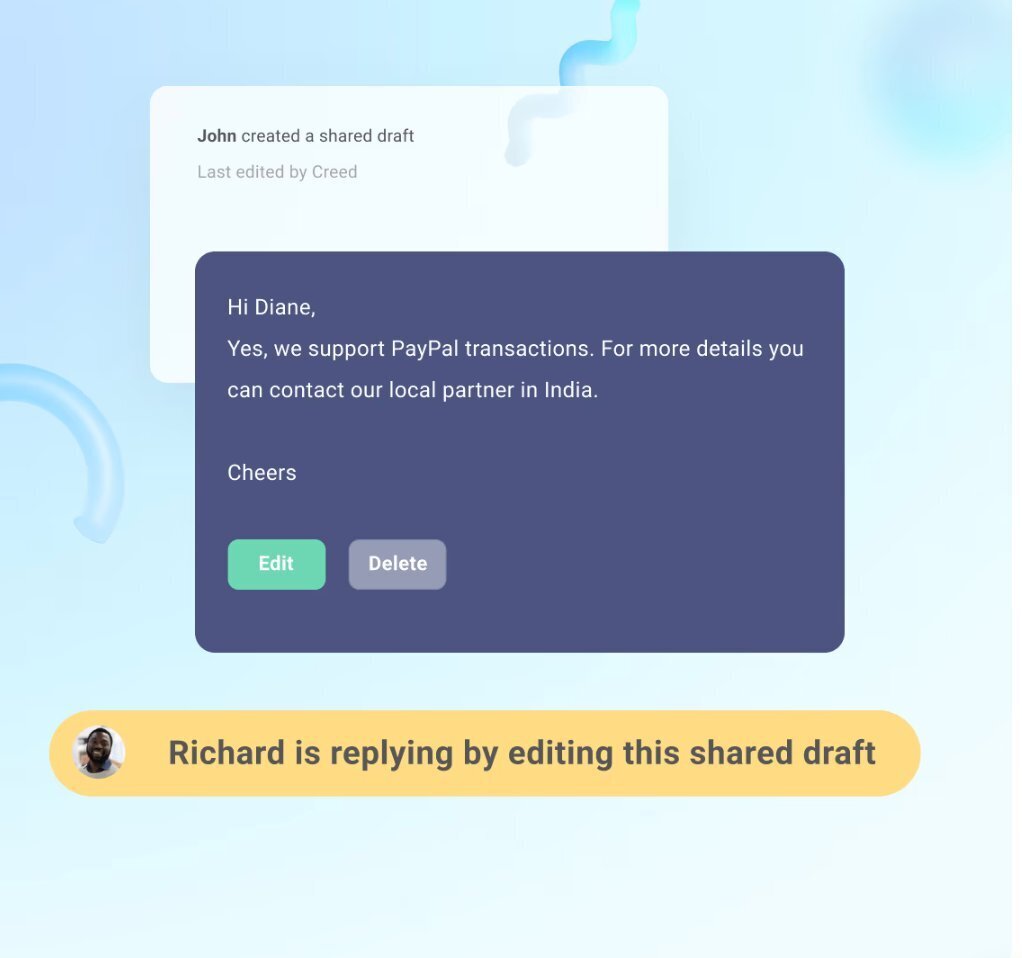
4. Automation
Hiver’s automation capabilities are designed to optimize workflow efficiency:
- Automatic Email Routing: Queries can be automatically assigned to team members based on predefined rules, such as the email’s content, sender, or subject line. This ensures that emails are promptly directed to the right person.
- SLA (Service Level Agreement) Management: Hiver allows setting up SLA reminders and warnings, ensuring that customer queries are addressed within the agreed-upon timeframes.
- Workflow Automation: Routine tasks like categorizing, tagging, and marking emails can be automated, saving time and reducing manual errors.
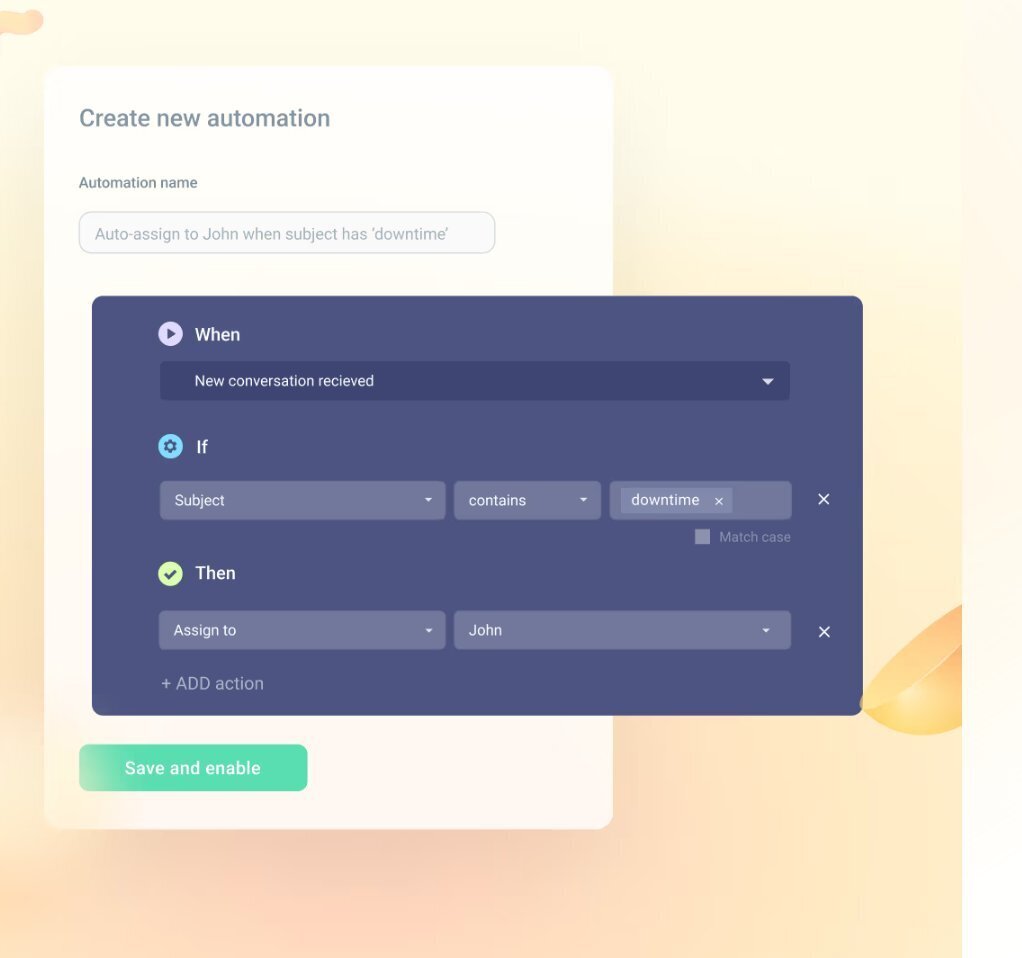
5. Reporting and Analytics
Let’s take a closer look at how Hiver’s Reporting and Analytics can help you enhance your customer service.
- Response Time and Resolution Time: Hiver tracks how long it takes for your team to respond to a new query and how long it takes to fully resolve an issue. These metrics are essential for assessing the efficiency and effectiveness of your customer support.
- Volume Trends: The tool provides insights into the volume of emails received over different periods. This can help in identifying peak times and planning resource allocation accordingly.
- Tailored Dashboards: You can create customized dashboards in Hiver to focus on the metrics that matter most to your business – be it tracking specific types of queries or monitoring the performance of individual team members.
- Data Export: The ability to export data for further analysis is a valuable feature. You can use this data for detailed reporting, presentations, or integrating with other analytics tools.
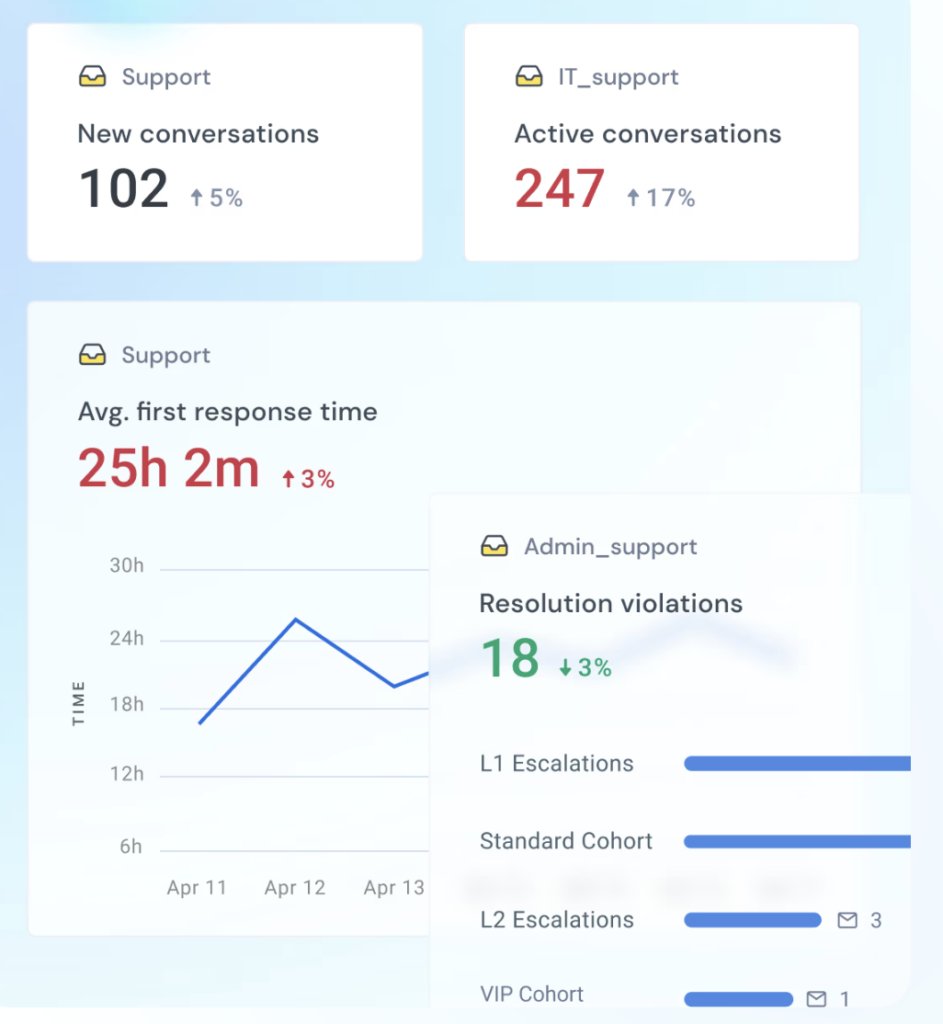
6. Proactive Customer Support
Hivers offers round-the-clock proactive support across all its plans, ensuring that no matter the time or issue, expert assistance is always available. This 24/7 support model is designed to provide continuous, real-time solutions to clients, enhancing the overall reliability and responsiveness of Hivers’ services.
Here’s a user review on Hiver’s support:
“It (Hiver) is easy to administrate, very user friendly, and the support is phenomenal. I don’t think I’ve ever waited more than a few seconds for a response from a member of their friendly and extremely competent support team.“
–Hiver’s user review on Captera
7. Pricing
Hiver offers four main pricing plans as of 2025. It offers a forever free plan that comes with some powerful help desk functionalities to try out. Paid plans start with as low as $19/user/month and can go up to $79/user/ month. This means, even when you choose a higher plan, you’ll be paying considerably less than what you would have to pay for Zendesk or intercom.
Also, all of Hiver’s pricing plans come with a 7-day free trial, and no credit card is required to sign up for the trial.
Final Words
Zendesk and Intercom are both incredibly powerful customer support tools, and they have their own strengths and weaknesses. Choosing between the two really boils down to your business demands. Zendesk excels in traditional ticket management and offers a robust set of feature. On the other hand, Intercom’s cutting-edge AI capabilities and in-app messaging features help companies provide a more intuitive and on-the-go customer support.
However, for businesses seeking a more cost-effective and user-friendly solution, Hiver presents a compelling alternative. It works on top of your inbox and offers essential helpdesk functionalities.
Want to give Hiver a shot? Try it out for free
Frequently Asked Questions (FAQs)
- What is the primary difference between Zendesk and Intercom?
Zendesk is primarily a customer support platform focused on ticket management, while Intercom is a customer engagement platform that prioritizes in-app messaging AI driven query resolutions.
- Can I use both Zendesk and Intercom together?
Yes, many businesses use both platforms to complement their customer support and engagement strategies.
- Is there a free version of Zendesk and Intercom?
No, both Zendesk and Intercom don’t have free plans for ongoing use. However, they both offer a free trial period of 14 days.
- Which platform has better reporting and analytics?
Both Zendesk and Intercom offer robust reporting features. That said, Zendesk typically provides insights into key customer support metrics whereas Intercom’s analytics dashboard focuses on user behaviour trends.
- I am running a small business and have a small budget to invest on a helpdesk. Which plan should I choose?
If you compare the basic plans of Zendesk and Intercom, Intercom is cheaper. However, adding advanced features can make it way costlier than Zendesk. if you’re a small business with a limited budget, Hiver might be a more suitable option. It offers essential helpdesk features without the high price tag of Zendesk or Intercom.











